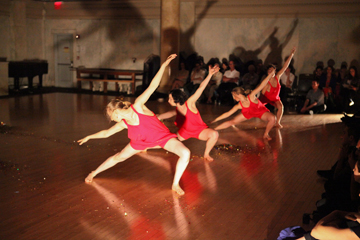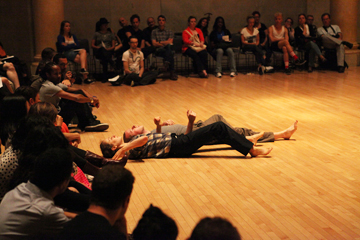Dance: Judson Church is Still Preaching the Arts
By Dawn Lille
ART TIMES Winter 2013
 Karen Harvey Dances. (Photo by Hope Davis, 2012) |
Say “Judson Church” to anyone in dance and the immediate response is “post modern dance in the 60’s and 70’s.” Back then dancers and choreographers were eliminating technique, narrative, music and form. Anyone was welcome on stage, from a person on the street to your grandmother. From that often intensely chaotic, but always democratic and intimate atmosphere, blessed by the Reverend Al Carmines, a musician and composer, emerged a different approach to dance and theater.
Today, Judson Church, on Washington Square South, is alive and well and has hardly changed physically, except for the addition of some bleacher seating. Micah Bucey is the minister in charge of the arts and the church is exploding with youth and creativity.
Bucey, from Ohio, is the son of a minister. Growing up he was always interested in theater and music, as well as the church. He moved to New York where he attended Fordham as a theater major. While in school he came out as a gay man and started to deal with how to align that with the fundamentalism in religion. He felt he had to renegotiate spirituality and sexuality.
While dealing with this issue Bucey worked for a few years at an artist’s agency run by two women. He began to see them as ministers devoted to making the arts happen, but he also observed that some artists were losing the joy in their work. He had read about Al Carmines and was familiar with Irene Fornes, who had been part of the early Judson Theater. He started to “hang out” at Judson in 2009. Bail Out, a soup kitchen followed by a movie, had begun the previous year.
Bucey suggested that live theater would be better and was soon handed the task of making this happen. First he was a volunteer, than worked part-time and is now a full-time Community minister of the arts. Judson’s two regular ministers, Donna Schaper and Michael Ellick, gave him and Johnny Goodman, his co-worker, carte blanch to usher in Bail Out as live theater in 2010. Seen one night a month it is playwright specific and involves writers, actors and directors. Every other month it is dance.
John Sorensen-Jolink is a member of the Judson congregation. A native of Portland, Oregon, he attended Lincoln High School there. It is part of a cooperative with Jefferson High School, which has a dance program, the classes of which are open to anyone in the Portland area. Students can therefore take their academics in the morning in one school and their electives in dance. After attending both and graduating, he came to New York to study at the Tisch School of the Arts.
Carlye Eckert, a friend in Portland, followed a similar path two years later and came to Juilliard to complete her education. Carlye and Johnny both remained in New York as free lancers performing for others and creating their own work, often together. She has danced with Tino Sehgal, Jonah Bokaer, Jack Ferber, Azure and Artists and Keigwin + Company. He has performed with Doug Elkins, Lucinda Childs, Twyla Tharp, Tino Sehgal and John Jasperse. Both were seen recently at MOMA in the series by the French choreographer Boris Charmatz.
 Austin Selden and Sarah Konner. (Photo by Hope Davis, 2012) |
After they danced at one of Judson’s regular Sunday services Bucey, who says he does not trust himself with dance, approached them. Together they came up with STUFFED, a series of evenings of food and dance curated by Carlye and Johnny.
STUFFED, like Bail Out, offers a free performance preceded by a free dinner, some of it donated by local restaurants and markets and some cooked by members of the church. None of the artists are paid, so no money is exchanged on any level.
Originally scheduled for once a month, it proved to be a big job for two unpaid “artists-in-residence,” so it may now be seen every other month. (They do have use of the gym, when it is free, to develop their own work.)
When they began in 2011 (December 4 will be their tenth program) they wanted to make an evening that was different from other platforms but was tasteful and succinct, with pieces ten to fifteen minutes long. They are exposing these dance artists to an audience that is different – often filled with a diverse group of people who otherwise might never see a dance performance. Sometimes young dancers and choreographers are dancing for dancers, but this is not the case at Judson. Also, since the technical support is minimal, they have to give up the idea of a fantastic performance in exchange for an atmosphere in which one can create a community full of ideas.
Sometimes, if a work is bad the audience may not know it, but one has to take into account a broad spectrum of taste. These two fresh curators are trying to give an opportunity to emerging, usually independent, dance artists who have not had a chance to show their work elsewhere and to erase the concept of dance as an elite art. Many choreographers such as Charlotte Bydwell, Jack Ferber and Celia Rowlson Hall have gone on to wider exposure.
Bucey points out that, as a church, Judson has always emphasized social values and he sees the performances as an arena to trade energies. He and Eckert and Sorenson-Jolink feel it is possible to create an expanded audience community. He notes that a dance performance can generate an audience of 250 as opposed to 75 for other events.
People like to compare Micah Bucey to Al Carmines and there certainly are similarities. Bucey, who will be ordained in June by the United Church of Christ, considers himself an actor and a lyricist by trade. He and Nicholas Williams, a composer, call themselves Gay Agenda and write musical theater. He sees himself most like Carmines when he observes the potential creativity in everyone. The spiritual to him is being able to help artists, especially those to whom others have said “no.” For him, artists using space and time at Judson are a connection to God.
Carlye, Johnny and Micah are all concerned with connecting to others via art. As curators of STUFFED, the two former feel it is important for the audience to ask questions, to invite people into an experience that will develop and change them and their opinions. To Micah this is perfectly in tune with religion: both a parable of Jesus and an abstract dance can lead to self and learning.
Carlye, who feels privileged to be at Judson, is not sure where dance is going, whether it is good or bad that it is becoming so much a part of museum shows, or whether dancers and choreographers, like their fellow artists, will ever be able to earn a decent living. Johnny points put that, world-wide, dance is losing its funding and being pushed to the sidelines, but in societies that value dance those practicing it enjoy a good quality of life
With STUFFED they are trying to find new ways to give value to dance, albeit slowly. Micah considers artists to be modern day prophets and this dance venue is certainly allowing them to express thoughts and feelings in a completely free atmosphere, although it does not pay the rent. Judson, meanwhile, is quietly continuing its legacy as one of the most relevant centers for the arts in New York City.
